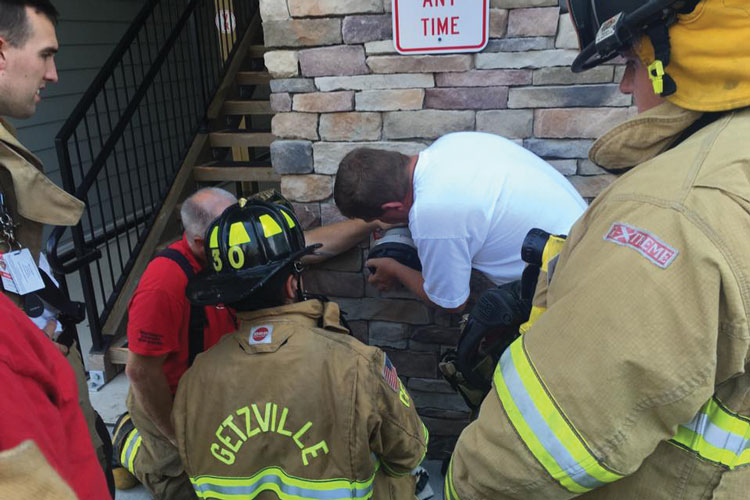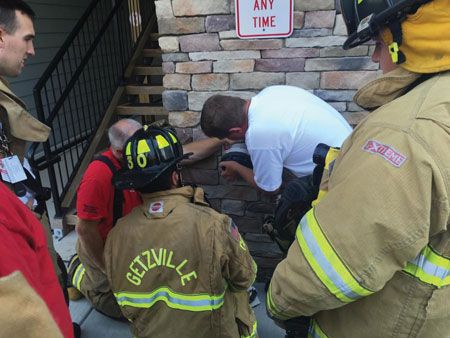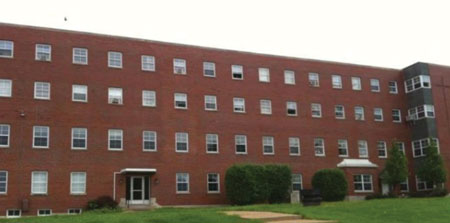
By THOMAS A. MERRILL
One of the many challenges our volunteer fire departments face is conducting effective training drills. Even more challenging is creatively engaging members while producing an exciting training environment that motivates them and stimulates discussion after the drill. One way to sharpen members’ skill sets and, hopefully, create the desired excitement and continued dialogue is to implement what I call the “What If” Drill.
Often, we respond to alarms that turn out to be a malfunction, an accidental activation, or maybe nuisance smoke from cooking. When picking up and going back into service, instead of simply hopping back on the rig to go back to the firehouse or letting members drive away in their personal vehicles, gather the members around the rig for five minutes and ask them, “What if?”
 |
| (1) Before leaving the scene of a routine fire alarm activation at a commercial building, these firefighters familiarized themselves with the fire department connection. In addition to reviewing how to properly hook up the feeder hose, the officer also reviewed the department’s SOPs for standpipe-equipped buildings. (Photos by author.) |
What if smoke was showing on arrival? What if this simple call turned into something more serious? What if this was a working fire and the crew with you at that moment was all you had during the event’s first 10 minutes?
Use these questions as a bridge to a more in-depth discussion that can lead to many more questions. During a fire, how would you use the crew on hand? What is your standard operating procedure (SOP) for apparatus positioning? Where would you get water? Are there any hazards? Would the standard 200-foot preconnect reach the seat of the fire? What if nothing was showing on arrival and crews then discovered a fire? Are the rigs positioned properly? Are crews properly dressed and equipped? Do you have enough people to stretch a line properly? Are there enough lines on hand to properly secure a water source? What if you have limited staffing? Get the idea?
The Challenging Questions
There certainly is no shortage of challenging questions you can ask to help enhance the learning process and make your members better prepared and, hopefully, more engaged. You can even go one step further and ask more specific “what if” questions such as the following: What if a fire was discovered in the basement? What if it was a second-floor fire? What if people were trapped at the windows around the rear of the building? You can do this even at a routine medical call because you don’t need to be at a fire call to discuss fire tactics and your department’s SOPs. However, nothing beats doing this while on location, in the mode, geared up, and with the rigs and crews ready to go; it sets the perfect tone.
 |
| (2) Firefighters look over the layout and hazards in the basement of an apartment building after they rendered care at an emergency medical services call. |
You can also generate meaningful questions and further the training experience by becoming familiar with the buildings and complexes in your response area. “What if” you take a look around? Find the basement access and see what’s down there. Go to the attic and look at what type of roof the building features. Are there multiple roof layers? You can gather a lot of information by conducting these impromptu building tours. In the volunteer ranks, we sometimes have more people at a medical call than we might need. Rather than have your members stand outside making idle conversation, engage them by practicing the “What If” Drill or taking a walk-around to become more familiar with the building. You can also practice aerial truck positioning and extending the ladder at fire alarm calls.
Put Them on the Spot
Keep members on their toes and, at the same time, reinforce some great lessons they need to learn and master by asking them specific questions regarding a response as they exit a building, such as the following: What floor were you on when treating the patient? If the primary exit was inaccessible, where was the secondary exit? Did you notice a fire department connection on the building on arrival? These questions build great habits and ultimately make your firefighters better prepared and more educated.
You can take “What If” Drill scenarios a step further back at the firehouse. While there, grab a fire magazine, pick an article, and ask members questions such as, What if this was our fire? What if this was our rescue? What would we do? What are the similarities? What are the differences? What can we learn from this? How can we be better prepared? You can even develop training drills around some of the stories you read and the questions you develop from them.
 |
| (3) A typical apartment building found in many fire districts. At routine calls, officers can engage members by practicing the “What If” Drill and discussing with them various fire scenarios and atypical situations. You can also do this at residential homes and commercial buildings. Build good habits ahead of time by asking, “What if?” |
You can also find many video clips online to use for “What If” Drill scenarios. However, remember that you are trying to learn from them and enhance your training and learning experiences, not to bash and make fun of your fellow firefighters. Learn from the mistakes and successes of others, and always do it professionally and respectfully.
The “What If” Drill is a great way to creatively engage your members in a nontraditional drill setting. This can take a few minutes, but it can pay long-lasting dividends by reviewing and reinforcing SOPs while stimulating interest and furthering discussions both on scene and back in the firehouse. The drill helps to build great habits and ultimately makes your firefighters better prepared for the dangerous jobs they do.
THOMAS A. MERRILL is a 35-year fire service veteran and a member of the Snyder Fire Department (SFD) in Amherst, New York, where he has served 26 years as a department line officer including 15 years in the chief officer ranks and chief of department from 2007-2012. Merrill is also a fire commissioner for the SFD and a full-time fire dispatcher for the Amherst (NY) Fire Alarm Office.
Back-to-Basics Drilling for the Engine Company, Part 2
What is a “Routine” Fire?
Bread-and-Butter Training Tips: Start Smart
Fire Engineering Archives

